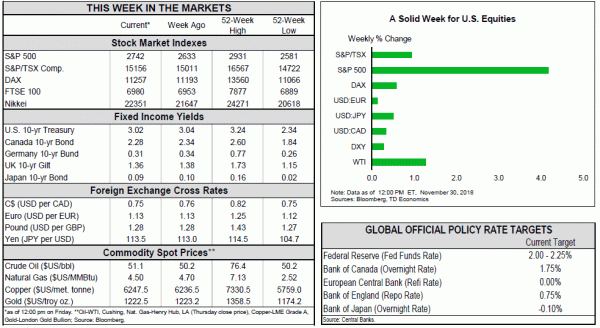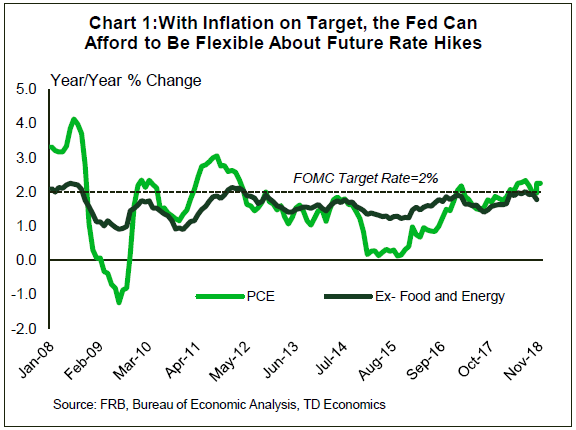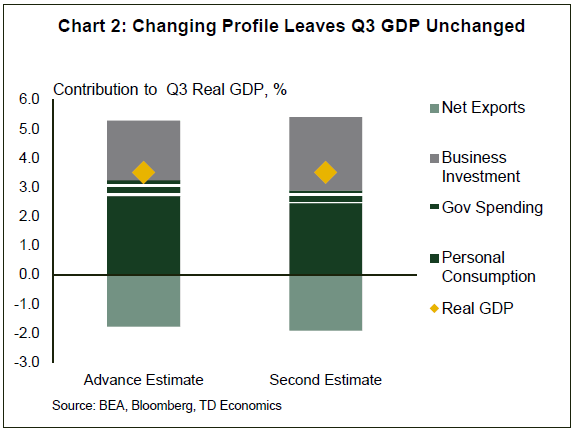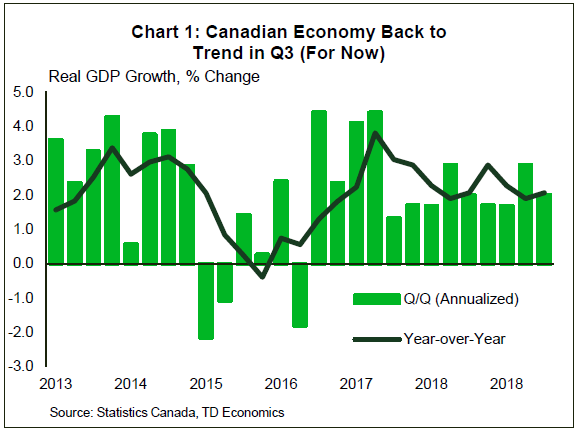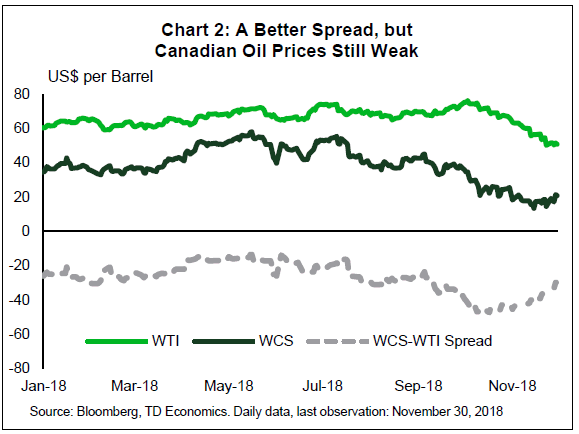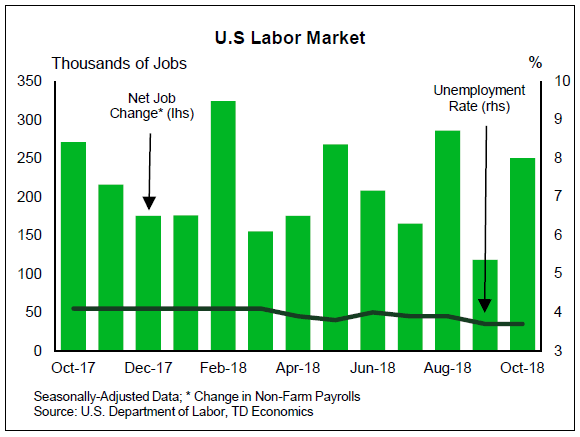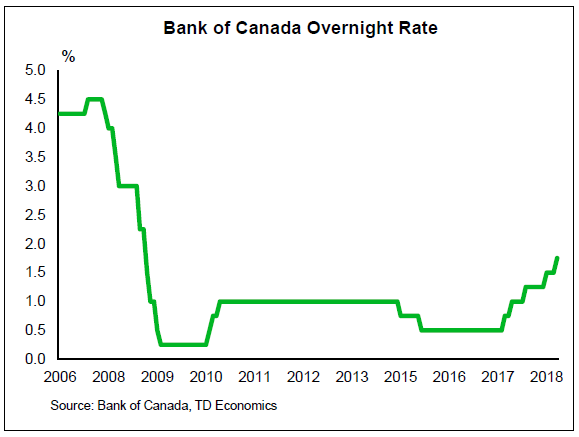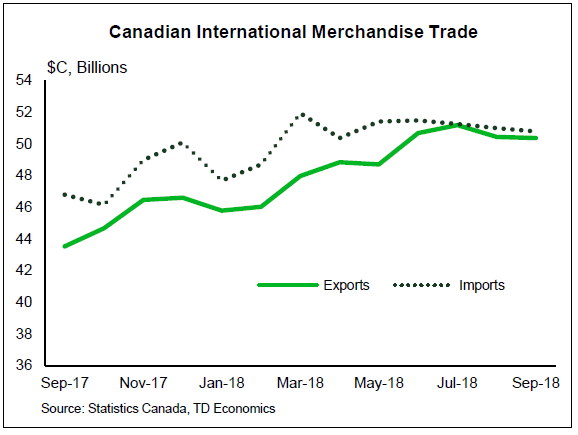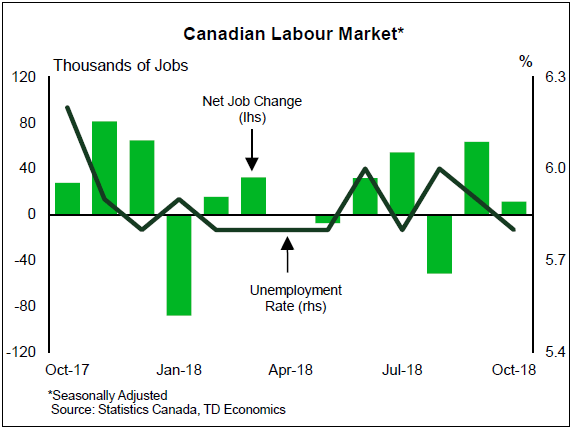U.S. Highlights
- FOMC minutes released this week suggested that flexible could be the new gradual for the Fed. While a rate hike for December may be in the cards, future moves are now more dependent on the incoming economic data.
- President Trump and Xi are set to meet-up at the G20 summit over the weekend. Stakes are high for an agreement to be reached. If not, higher tariffs are set to kick-in come January.
- While cracks are starting to show in the armor of the U.S. economic expansion, there’s still plenty that’s going well. Q3 GDP growth remained solid, consumer spending is strong, income gains are healthy and inflation is contained.
Canadian Highlights
- The announcement that GM is shuttering its Oshawa production plant was another blow to the Canadian outlook this week.
- The Canadian economy grew by 2.0% in the third quarter, a step down from 2.9% in Q2, but broadly in line with expectations. The details were decidedly more negative as investment disappointed and real GDP pulled back on a monthly basis in September.
- The Bank of Canada meets next week and is universally expected to hold interest rates at 1.75%. We will be watching its statement for hints to its interpretation of recent economic challenges.
U.S. – Yellow is the New Green?
Financial markets responded to the message of Fed Chair Powell on Wednesday that the fed funds rate was “just below the broad range of estimates of…neutral,” after previously stating that it was a “long way” away. Market participants took the subtle shift in narrative as a sign that the Fed may be easing the pace of rate hikes in the New Year. Both stock and bond markets rallied in response.
FOMC minutes suggest that a rate hike in December is all but a done deal, but the path thereafter is more uncertain. Indeed, Fed members emphasized the need to maintain flexibility in order to respond to changing economic data. A shift in tenor from possible overheating to slower-than-expected growth was also discernible in the details of the discussion. Trade tensions in particular were “cited as a factor that could slow economic growth more than expected.”
In that vein, the trade tug-of-war with China continues. The hope is that negotiations go well at the G20 meetings in Buenos Aires that kicked-off Friday. The stakes are high. President Trump signaled prior to the meeting that if the two countries failed to reach an agreement favorable to the U.S., additional tariff on virtually all U.S. imports from China would be forthcoming. Such a development would exacerbate the slowdown in global growth – another risk flagged by the Fed.
Further underscoring the concerns raised in the Fed minutes are recent economic and financial data. Signals of slowing activity are most apparent among the interest-rate-sensitive housing and auto sectors, but other indicators also showing signs of deceleration. Initial jobless claims have been trending up in recent weeks, rising to a six-month high in the most recent data, while capital goods orders have also turned south, suggesting business investment growth may also be easing. Meanwhile, there are few signs of inflationary pressures. After hitting 2.0% in July, core PCE inflation fell to 1.8% in October. The recent trend is even softer, with price growth averaging just 1.2% over the past three months.
The good news is that consumers are showing little sign of fatigue. Consumer spending grew robustly in October, rising 0.4% and setting the stage for a strong showing in the final quarter of this year. Holiday spending may get a further lift as households spend the extra coin left in their wallets after filling up at the gas pumps. Revisions to third quarter GDP were similarly encouraging (Chart 2) with business and residential investment revised up.
Overall, the economic data flow out of the U.S. this week was relatively balanced. Unfortunately, the downside risks to the outlook are mounting. It became clearer this week that the Fed is paying more attention to these risks and the economy may not need as many rate hikes as they believed back in September. All said, yellow may become the new green for the still-global-growth-leading U.S. economy.
Canada – Mama Said There’ll Be Days Like This
It has certainly been a tough couple of weeks for the Canadian economy. The announcement that General Motors will not allocate production to its Oshawa plant beyond 2019 was the latest in a string of sour news for the growth outlook. With continued malaise in the oil patch, two of Canada’s stalwart industrial sectors are under pressure.
On the latter, the WTI price hovered just above the $50 mark this week, after falling nearly a third over the past month. While the discount on Western Canadian Select has moved in the right direction for Canadian producers recently, the price is still low by historical standards at just above $20 (US) – still a level that risks further production shut-ins. The oil market is awaiting the next OPEC meeting on December 6th, where the group is expected to agree to production cuts to help balance the market.
The impact of the Oshawa closure is likely to be a modest reduction in Canadian economic growth, to the tune of 0.1 percentage points. In Ontario, the effect will be more pronounced, perhaps as much as 0.3 percentage points. In addition to the 2,500 workers directly employed at the plant, the overall number of jobs lost could double that, reflecting losses at suppliers and the reduced spending of those workers. It appears that production will run off slowly over the course of 2019, reducing the upfront impact, although the exact plans are still unclear. Previously published auto production schedules (built into GDP expectations) had not allocated any output to the “Oshawa 2” truck production line in 2020, so to some extent a reduction was already baked into the pie.
As this news is digested, this week we were treated to news that economy grew by 2.0% (annualized) in the third quarter, a step down from the 2.9% pace in the second quarter. The details were considerably softer than the headline. Economic activity slowed through the quarter, with real GDP falling 0.1% in September. This is a soft handoff for growth in the fourth quarter, even before the oil-related shut-ins weigh on growth. Just as disappointing, non-residential business investment fell by 7.1%. While there appear to be some temporary factors at play – investment in the very volatile aircraft and other transportation equipment was a significant drag – the weakness belies the reported strength of business confidence and capacity pressures that augured for growth.
It was nice to see the USMCA signed in Buenos Aires this week (although this still does not guarantee its passage through Congress), but with still significant competitiveness challenges, the pressure on policy makers to support economic growth will remain. The Bank of Canada meets next week to announce its interest rate decision. We expect some discussion of these headwinds in its statement, and a more cautious approach to raising interest rates over the next year reflecting the new challenges.
U.S.: Upcoming Key Economic Releases
U.S. Employment – November
Release Date: December 7, 2018
Previous: 250k, unemployment rate: 3.7%,
TD Forecast: 215k, unemployment rate: 3.7%,
Consensus: 200k, unemployment rate: 3.7%
We expect payrolls to rise by 215k in November, as growth reverts back toward its recent trend. The swing in payrolls over the prior two months suggest that hurricane impacts are complete. Removing the volatility, 3- to 6-month averages stood at 216k and 218k respectively. We look for payrolls to therefore normalize but remain strong in line with the resilience seen in job surveys. Claims ticked higher but not in the reference week and could be related to holiday distortions. Wages also have scope for a strong 0.3% print given the reference week and Amazon hikes, leaving y/y growth higher at 3.2%. Finally, we expect the unemployment rate to stabilize at 3.7%.
Canada: Upcoming Key Economic Releases
Bank of Canada Rate Decision*
Release Date: December 5, 2018
Previous: 1.75%
TD Forecast: 1.75%
Consensus: 1.75%
We expect the BoC will leave the overnight rate unchanged at 1.75% next week, in line with market expectations. The communique should be fairly short, and while the Bank will note that weaker commodity prices present a headwind to the outlook, we expect that they will again warn that higher interest rates will be needed. The biggest question mark will be around the Bank’s treatment of the energy shock. Lower oil prices will materially suppress Q4 growth, and even if the impact is expected to be transitory markets will be looking for reassurance that a January rate hike is still a realistic possibility. If the Governor sounds overly concerned about falling oil prices, there is a risk that rates markets could rally sharply.
Canadian International Trade – October
Release Date: December 6, 2018
Previous: -$0.42bn
TD Forecast: -$1.1bn
Consensus: N/A
TD looks for the merchandise trade deficit to widen to $1.1bn in October on a rebound in import activity while lower energy prices will weigh on exports. Imports have fallen for three consecutive months and will benefit from a rebound in transportation equipment, while non-energy exports should be supported by stronger auto production and a pickup in advance US imports, although weaker energy exports will likely offset any gains. This is largely due to wider WCS/WTI spreads, which imply that real exports should outperform the nominal figure, although shut-ins throughout the oil sands will weigh on real exports going forward.
Canadian Employment – November
Release Date: December 7, 2018
Previous: 11k, unemployment rate: 5.8%,
TD Forecast: 25k, unemployment rate: 5.7%
Consensus: N/A
TD looks for job growth to pick up to a 25k pace in November led by further gains in the services sector. Employment in goods producing industries will see a drag from oil and gas, where the blowout in WCS spreads has led firms to shut-in production, although this should be offset by hiring elsewhere in the goods sector. Job growth of 25k will allow the unemployment rate to edge lower to 5.7% although wage growth will paint a more downbeat picture, with average hourly earnings forecast to slip to 1.8% y/y.




